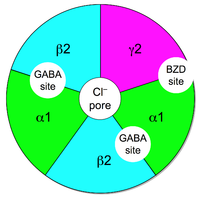
Photo from wikipedia
Background Allosteric modulation of G protein-coupled receptors (GPCRs) is nowadays one of the hot topics in drug discovery. In particular, allosteric modulators of D2 receptor have been proposed as potential… Click to show full abstract
Background Allosteric modulation of G protein-coupled receptors (GPCRs) is nowadays one of the hot topics in drug discovery. In particular, allosteric modulators of D2 receptor have been proposed as potential modern therapeutics to treat schizophrenia and Parkinson’s disease. Methods To address some subtle structural and stereochemical aspects of allosteric modulation of D2 receptor, we performed extensive in silico studies of both enantiomers of two compounds (compound 1 and compound 2), and one of them (compound 2) was synthesized as a racemate in-house and studied in vitro. Results Our molecular dynamics simulations confirmed literature reports that the R enantiomer of compound 1 is a positive allosteric modulator of the D2L receptor, while its S enantiomer is a negative allosteric modulator. Moreover, based on the principal component analysis (PCA), we hypothesized that both enantiomers of compound 2 behave as silent allosteric modulators, in line with our in vitro studies. PCA calculations suggest that the most pronounced modulator-induced receptor rearrangements occur at the transmembrane helix 7 (TM7). In particular, TM7 bending at the conserved P7.50 and G7.42 was observed. The latter resides next to the Y7.43, which is a significant part of the orthosteric binding site. Moreover, the W7.40 conformation seems to be affected by the presence of the positive allosteric modulator. Conclusions Our work reveals that allosteric modulation of the D2L receptor can be affected by subtle ligand modifications. A change in configuration of a chiral carbon and/or minor structural modulator modifications are solely responsible for the functional outcome of the allosteric modulator. Graphical abstract Supplementary Information The online version contains supplementary material available at 10.1007/s43440-021-00352-x.
Journal Title: Pharmacological Reports
Year Published: 2022
Link to full text (if available)
Share on Social Media: Sign Up to like & get
recommendations!